Book contents
- Frontmatter
- Contents
- Series editors' preface
- Preface
- I FOUNDATIONS OF READING
- II PATTERNS OF VARIATION IN READING
- Chapter 6 Reading in different languages
- Chapter 7 L1 and L2 reading relationships
- Chapter 8 The social contexts of reading
- Chapter 9 Motivation for reading
- III DEVELOPING READING COMPREHENSION ABILITIES
- IV EXPANDING READING COMPREHENSION SKILLS
- References
- Author Index
- Subject Index
Chapter 8 - The social contexts of reading
from II - PATTERNS OF VARIATION IN READING
Published online by Cambridge University Press: 05 August 2012
- Frontmatter
- Contents
- Series editors' preface
- Preface
- I FOUNDATIONS OF READING
- II PATTERNS OF VARIATION IN READING
- Chapter 6 Reading in different languages
- Chapter 7 L1 and L2 reading relationships
- Chapter 8 The social contexts of reading
- Chapter 9 Motivation for reading
- III DEVELOPING READING COMPREHENSION ABILITIES
- IV EXPANDING READING COMPREHENSION SKILLS
- References
- Author Index
- Subject Index
Summary
Striking differences in material resources and in the quality of the home environment, as expressed by parents' interactions, their skills, habits, and styles, begin to define what children are taught … and these differences are the key to understanding the beginnings of the social stratification of knowledge.
(Neuman, 2006: 32)Most efforts to describe the nature of reading abilities and their development, for either first-language or second-language readers, focus heavily on the cognitive aspects of reading – the mechanisms by which an individual carries out fluent reading. In fact, much progress has been made in understanding the cognitive aspects of reading, and reading development cannot be discussed without considering these aspects. However, there is considerable variation across different individuals' reading abilities, and not all of this variation is due solely to individual cognitive abilities and their development. We all learn to read in a variety of contexts, from the time we encounter our first books or are read to as children, to the times when we are reading advanced research material as professional adults. We learn to read within a family unit (influenced by the educational levels, goals, expectations, and support of family members), in various school settings (and their associated goals, resources, expectations, and opportunities), in various classrooms (with differing curricular and instructional approaches), and by interacting with specific teachers and student peers (and their goals, training, expectations, and abilities).
Students are also influenced by the wider social and cultural expectations of political, religious, ethnic, economic, and social institutions. Certainly, popular culture has profound influences on children and young adults learning to read, and neighborhood influences, both formal and informal, cannot be overlooked.
- Type
- Chapter
- Information
- Reading in a Second LanguageMoving from Theory to Practice, pp. 152 - 174Publisher: Cambridge University PressPrint publication year: 2008

